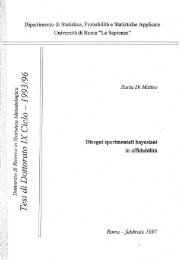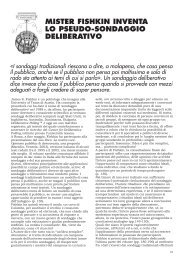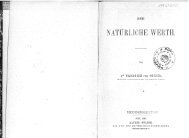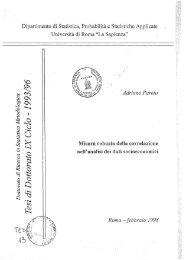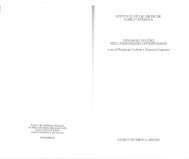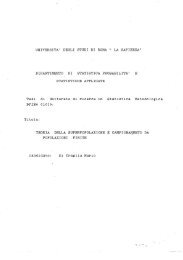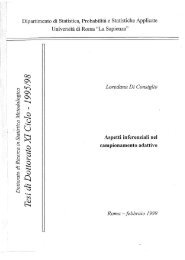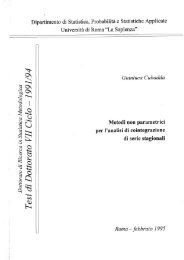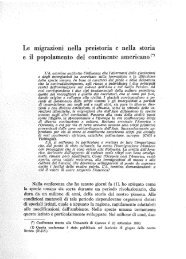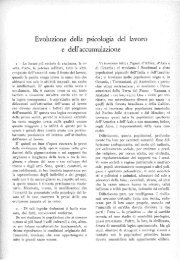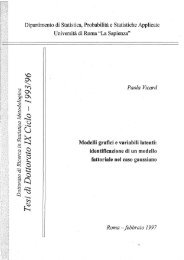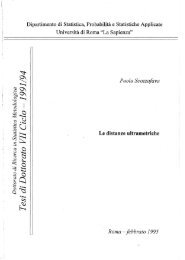Random Processes in Hyperbolic Spaces Hyperbolic Brownian ...
Random Processes in Hyperbolic Spaces Hyperbolic Brownian ...
Random Processes in Hyperbolic Spaces Hyperbolic Brownian ...
You also want an ePaper? Increase the reach of your titles
YUMPU automatically turns print PDFs into web optimized ePapers that Google loves.
43 <strong>Hyperbolic</strong> <strong>Brownian</strong> Motion<br />
3.2.3 <strong>Hyperbolic</strong> <strong>Brownian</strong> bridge<br />
Let {Bz1 (t), t ≥ 0} be a Euclidean <strong>Brownian</strong> motion <strong>in</strong> Rn start<strong>in</strong>g from z1 ∈ R n , n ≥ 2, then the<br />
Euclidean <strong>Brownian</strong> bridge {W (t), t ∈ [0, 1]} between z1 and z2 ∈ R n is given by<br />
W (t) = Bz1 (t) + t[z2 − Bz1 (t)]<br />
for every t ∈ [0, 1]. For the <strong>Brownian</strong> bridge <strong>in</strong> the Euclidean space we have that the probability<br />
that it stays uniformly close to the l<strong>in</strong>e jo<strong>in</strong><strong>in</strong>g z1 and z2 does non depend on the distance between<br />
z1 and z2.<br />
Let U(t) be the hyperbolic <strong>Brownian</strong> bridge <strong>in</strong> H n , n ≥ 2, between the orig<strong>in</strong> O and z ′ ∈ H n ,<br />
Eberle (see (13)) proved that on the hyperbolic space H n the sample paths of the hyperbolic<br />
<strong>Brownian</strong> bridge actually concentrate, accord<strong>in</strong>g to some exponential rate, around the geodesic<br />
through O and z ′ when z ′ tends to <strong>in</strong>f<strong>in</strong>ity <strong>in</strong> f<strong>in</strong>ite time. Simon <strong>in</strong> (39) has found the exact<br />
exponential rate of concentration <strong>in</strong> the case of the hyperbolic <strong>Brownian</strong> bridge on H 2 .<br />
Let lz ′ be the unique geodesic segment jo<strong>in</strong><strong>in</strong>g O to z′ and def<strong>in</strong>e the follow<strong>in</strong>g function on H 2<br />
d O z ′(·) = <strong>in</strong>f{η(·, z), z ∈ lz ′}.<br />
For every a > 0, it is possible to prove the follow<strong>in</strong>g<br />
lim<br />
η(O,z ′ )→∞ −<br />
1<br />
η(O, z ′ ) log<br />
<br />
P sup d<br />
0≤t≤1<br />
O <br />
z ′(U(t)) > a = 2 log cosh a.<br />
The proof of the above result is based on the comparison between the law of the hyperbolic bridge<br />
and that of the hyperbolic <strong>Brownian</strong> motion conditioned to tend toward <strong>in</strong>f<strong>in</strong>ity <strong>in</strong> the direction<br />
of z ′ .<br />
3.2.4 Fractional hyperbolic <strong>Brownian</strong> motion<br />
A generalization of the classical hyperbolic <strong>Brownian</strong> motion <strong>in</strong> H 2 is given <strong>in</strong> Lao and Ors<strong>in</strong>gher<br />
(26) where it is considered the time-fractional equation<br />
with α ∈ (0, 1], subject to the <strong>in</strong>itial condition<br />
∂α ∂tα uα = 1<br />
<br />
s<strong>in</strong>h η<br />
s<strong>in</strong>h η<br />
∂<br />
<br />
uα, (3.32)<br />
∂η<br />
uα(η, 0) = δ(η).<br />
We assume that the fractional derivative appear<strong>in</strong>g <strong>in</strong> (3.32) is understand <strong>in</strong> the sense of Dzerbashyan-<br />
Caputo that is, for f ∈ C m ,<br />
dαf =<br />
dtα t<br />
1<br />
Γ(m − α) 0<br />
f (m) (s)<br />
ds, m − 1 < α ≤ m.<br />
(t − s) α+1−m



